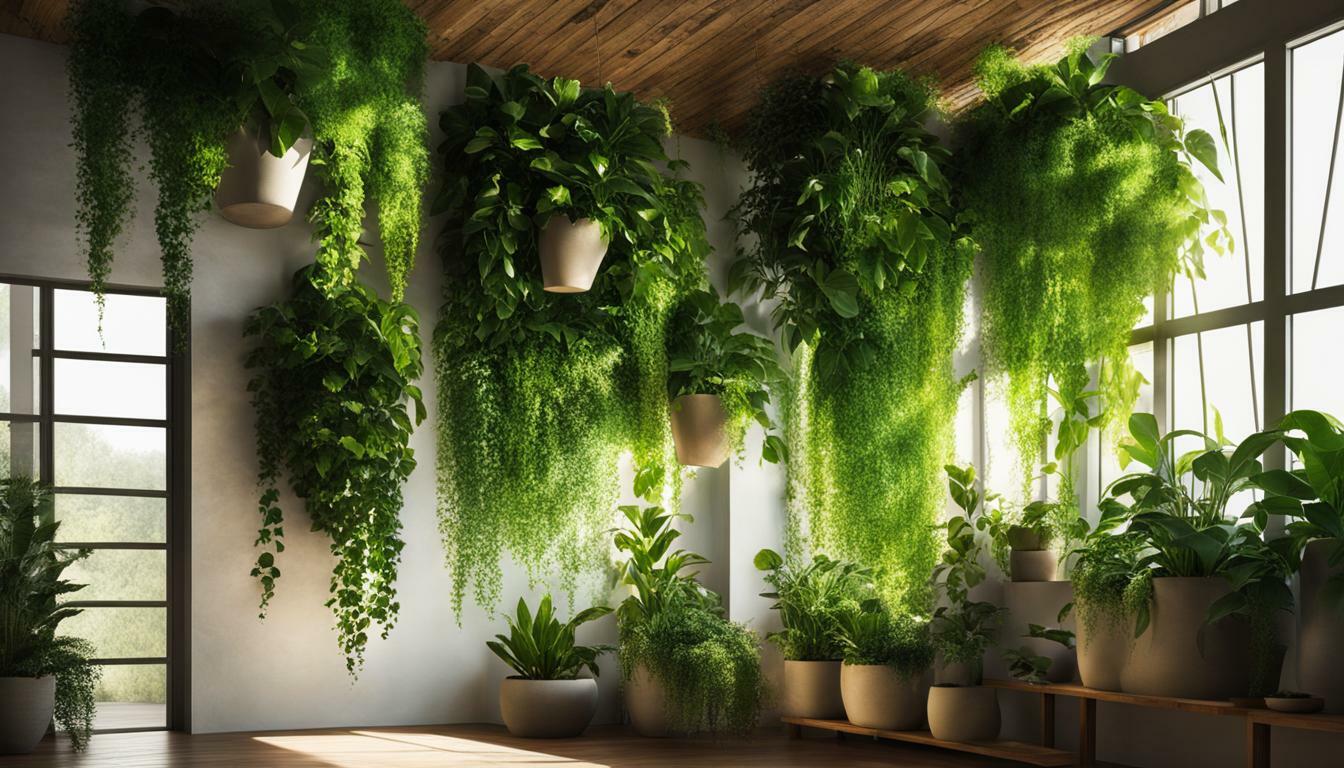Revolutionize your living space with a vertical indoor garden that combines aesthetics with eco-friendly living. A vertical indoor garden is a innovative way to bring nature into your home, even if you have limited space or live in an urban environment. By utilizing vertical space, you can transform unused walls into lush and vibrant living spaces.
Key Takeaways:
- A vertical indoor garden allows you to grow plants vertically without needing soil, making it perfect for small spaces.
- Indoor vertical gardens offer numerous benefits, including improved air quality, regulation of humidity levels, and natural insulation.
- Choosing the right plants and designing the layout are key considerations for a successful vertical indoor garden.
- Maintenance and care for your vertical indoor garden include regular watering, pruning, and pest control.
- Gardyn is a leading brand in vertical indoor gardening, offering innovative features and AI monitoring.
What is a Vertical Indoor Garden?
A vertical indoor garden is a modern gardening technique that uses hydroponics to grow plants in a vertical arrangement, maximizing space and promoting healthy growth. Unlike traditional gardens that rely on soil, vertical indoor gardens utilize nutrient-rich water solutions to nourish plants. This method, known as hydroponics, allows plants to grow without the need for extensive root systems, making it ideal for limited indoor spaces.
Vertical indoor gardens are designed to make the most of available space by utilizing vertical structures such as walls or frames. By growing plants vertically, gardeners can cultivate a wide variety of plants in a small area, making it an efficient and space-saving solution for urban dwellings or those with limited outdoor space.
Indoor vertical gardens can be easily installed and set up in any interior environment. They come in various sizes, shapes, and materials, allowing individuals to customize their garden to suit their preferences and available space. Whether you want to add greenery to your living room, create a herb garden in your kitchen, or grow fresh produce in your apartment, a vertical indoor garden provides a versatile and sustainable solution.
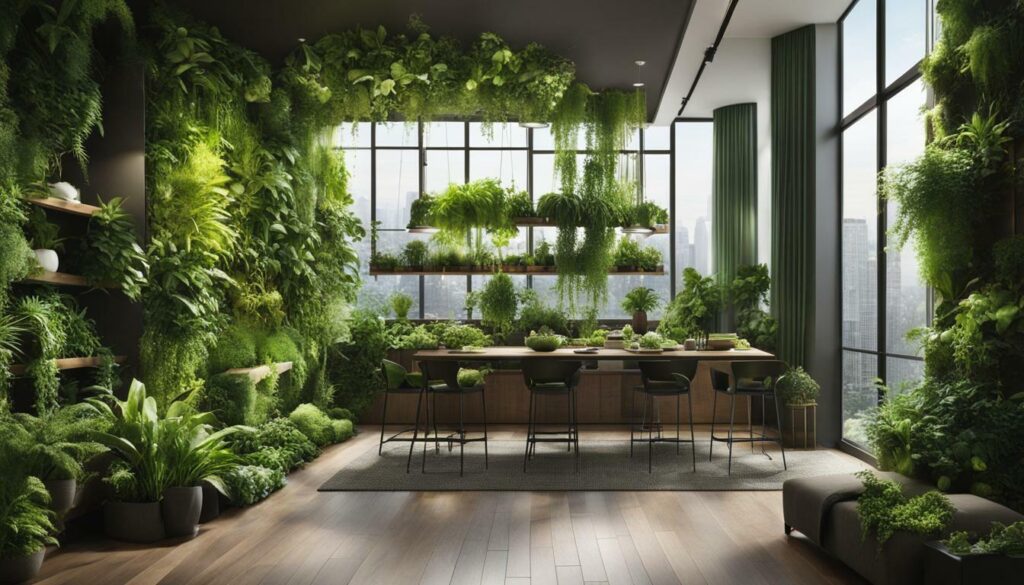
Benefits of a Vertical Indoor Garden:
- Maximizes Space: Vertical indoor gardens make efficient use of limited space by utilizing vertical structures, allowing you to grow more plants in a smaller area.
- Promotes Healthy Growth: Hydroponic systems provide plants with the necessary nutrients and water, creating an optimal environment for healthy growth and minimizing the risk of pests or diseases.
- Improves Indoor Air Quality: Vertical indoor gardens act as natural air purifiers, filtering toxins and releasing oxygen, which can improve the overall air quality in your home.
- Enhances Aesthetic Appeal: Vertical indoor gardens add a visually appealing element to any space, creating a lush and vibrant atmosphere that can enhance the overall aesthetic of your home.
- Provides Fresh Produce: Growing your own herbs, vegetables, and fruits in a vertical indoor garden allows you to enjoy fresh produce right at your fingertips, promoting a healthier and more sustainable lifestyle.
With their numerous benefits, vertical indoor gardens are revolutionizing the way we think about gardening and bringing nature into our indoor spaces. Whether you are an experienced gardener or a novice, a vertical indoor garden offers a practical and eco-friendly solution for creating a green oasis in any living environment.
Comparing Vertical Indoor Garden Kits:
| Brand | Features | Price |
|---|---|---|
| Gardyn | AI monitoring, automatic lighting and watering schedules, eco-friendly technology | $499 |
| Other Brand | Basic features, manual control, limited plant varieties | $299 |
When choosing a vertical indoor garden kit, it’s essential to consider the features and price to find the best option for your needs. Gardyn, a leading brand in vertical indoor gardening, offers advanced features such as AI monitoring, automatic lighting, and watering schedules, making it an excellent choice for both beginner and experienced gardeners. While other brands may offer more affordable options, they often lack the advanced technology and functionalities provided by Gardyn.
Benefits of a Vertical Indoor Garden
Embrace the benefits of a vertical indoor garden as it enhances indoor air quality, regulates humidity levels, and promotes eco-friendly living.
Indoor air quality is a major concern in modern living spaces, as indoor pollutants can have a negative impact on our health. Vertical indoor gardens offer a natural solution to this problem. Plants are known for their air-purifying abilities, as they absorb carbon dioxide and release oxygen. By incorporating a vertical garden into your space, you can significantly improve the air quality, reducing the presence of toxins and allergens.
Not only do vertical indoor gardens enhance air quality, but they also help regulate humidity levels. Plants naturally release moisture through a process called transpiration, which can increase humidity in the surrounding environment. This can be particularly beneficial in dry climates or during winter months when indoor air tends to be drier. By maintaining optimal humidity levels, you can create a more comfortable living space and reduce the need for artificial humidifiers or dehumidifiers.
Additionally, vertical indoor gardens act as natural insulation, helping to regulate temperature and reduce energy consumption. The layer of plants creates a barrier that can prevent heat loss in the winter and provide shade in the summer, making your space more energy-efficient. This not only reduces your carbon footprint but also lowers your energy bills.
| Benefits of a Vertical Indoor Garden | Eco-friendly Living | Indoor Air Quality |
|---|---|---|
| Enhances air quality by filtering toxins and releasing oxygen | Promotes sustainable living by reducing energy consumption | Regulates humidity levels for a more comfortable living environment |
| Acts as natural insulation, reducing the need for excessive heating or cooling | Reduces carbon footprint by improving indoor air quality | Creates a lush and vibrant living space |
“Vertical indoor gardens offer a natural solution to improving indoor air quality and creating a sustainable living environment.”
Transform Your Space with a Vertical Indoor Garden
By implementing a vertical indoor garden, you can transform your living space into a vibrant and eco-friendly oasis. Not only will you enjoy the visual appeal of lush greenery, but you will also reap the numerous benefits it provides. From enhancing indoor air quality to regulating humidity levels, a vertical indoor garden is a practical and stylish addition to any home or office.
To maximize the benefits of a vertical indoor garden, choose plants that are suited to your living space’s lighting conditions and maintenance requirements. Low-light plants such as pothos, spider plants, and peace lilies are excellent choices for indoor environments. Consider the space available for your vertical garden and ensure proper integration into your existing decor.
Whether you are a seasoned gardener or a novice, vertical indoor gardens offer a convenient and efficient way to bring nature indoors. With the availability of vertical garden kits, such as those offered by Gardyn, setting up and maintaining a vertical indoor garden has never been easier. Explore the options, choose the right plants, and start revolutionizing your space with a vertical indoor garden today.
Summary
- Vertical indoor gardens enhance indoor air quality by filtering toxins and releasing oxygen.
- They regulate humidity levels, creating a more comfortable living environment.
- Vertical indoor gardens act as natural insulation, reducing energy consumption.
- By implementing a vertical indoor garden, you can create a vibrant and eco-friendly living space.
Designing a Vertical Indoor Garden
Designing your vertical indoor garden involves maximizing space, considering lighting options, and integrating it seamlessly into your living space. With the increasing popularity of vertical gardening, there are various design techniques and tools available to help you create a functional and visually appealing indoor garden. Here are some key considerations to keep in mind:
Maximizing Space
One of the main advantages of vertical gardening is its ability to maximize space in smaller living areas. When designing your vertical indoor garden, consider utilizing vertical surfaces such as walls, fences, or hanging structures. This will allow you to grow plants vertically and make the most of your available space. Additionally, consider using tiered or cascading planters to create depth and add visual interest to your garden.
Another effective space-saving technique is utilizing vertical shelving or stacking planters. By stacking multiple tiers of planters, you can create a compact and efficient garden that takes up minimal floor space. This is particularly useful for apartments or homes with limited square footage.
Lighting Considerations
Proper lighting is crucial for the success of your vertical indoor garden. Most plants require adequate sunlight to thrive, so it’s important to consider the lighting conditions in your living space. Place your garden in an area that receives sufficient natural light, such as near a window or in a well-lit room.
If natural light is limited, consider using artificial lighting sources such as grow lights or LED lights specifically designed for indoor plants. These lights provide the necessary spectrum of light for optimal plant growth. Make sure to position the lights at the appropriate distance from your plants to prevent burning or stunting their growth.
Integrating into Your Living Space
Your vertical indoor garden should seamlessly blend into your living space and complement its existing decor. Consider the overall style and theme of your home when selecting the materials, colors, and plant varieties for your garden.
Choose planters that match your home’s aesthetic, whether it be modern, rustic, or minimalist. You can opt for hanging planters, wall-mounted planters, or freestanding structures based on your preference and the available space. Select plants that not only thrive in indoor environments but also enhance the visual appeal of your living space.
| Design Tips for Vertical Indoor Gardens |
|---|
| Utilize vertical surfaces like walls and fences to maximize space |
| Consider tiered or cascading planters for depth and visual interest |
| Use vertical shelving or stacking planters to save floor space |
| Ensure your garden receives sufficient natural or artificial light |
| Select planters and plants that complement your home’s decor |
| Choose plant varieties that thrive in indoor environments |
By carefully considering the design aspects of your vertical indoor garden, you can create a stunning and functional space that brings nature into your home. Experiment with different layouts, plant combinations, and decorative elements to personalize your garden and make it a unique reflection of your style and personality.
Vertical Indoor Garden Maintenance and Care
Proper maintenance and care are essential for the success of your vertical indoor garden, including regular watering, pruning, and pest control.
Keeping your vertical indoor garden in good condition requires attention to its daily care needs. By following a few maintenance practices, you can ensure that your plants thrive and continue to enhance your living space.
Watering
The key to successful vertical indoor garden maintenance is proper watering. Ensure that your plants receive sufficient water to stay hydrated, but avoid overwatering, as this can lead to root rot. Monitor the moisture levels in the soil and water as needed, taking into account factors such as plant type, temperature, and humidity levels. Consider using a drip irrigation system or self-watering pots to simplify the watering process and ensure consistent hydration for your plants.
Pruning
Regular pruning is necessary to maintain the health and appearance of your vertical indoor garden. Remove any dead or diseased leaves, stems, or flowers to prevent the spread of pests or diseases. Trim back overgrown branches to allow for proper airflow and prevent overcrowding. Pruning also encourages new growth and helps shape your plants, giving them a more aesthetic appeal.
Pest Control
Protect your vertical indoor garden from pests by implementing effective pest control measures. Inspect your plants regularly for signs of insects or pests, such as aphids or spider mites. If you notice any infestations, take immediate action to prevent further damage. Use organic or natural pest control methods, such as neem oil or insecticidal soap, to minimize harm to your plants and the environment. Additionally, practicing good hygiene, such as keeping your gardening tools clean and removing dead plant material, can help prevent pest infestations.
By prioritizing watering, pruning, and pest control, you can maintain a healthy and vibrant vertical indoor garden that enhances your living space. Regular maintenance and care will ensure the long-term success of your garden and allow you to enjoy its numerous benefits.
| Maintenance Tips | Frequency |
|---|---|
| Watering | Check soil moisture daily and water as needed |
| Pruning | As needed to remove dead or diseased plant parts and encourage new growth |
| Pest Control | Regularly inspect plants for pests and take prompt action if infestations occur |
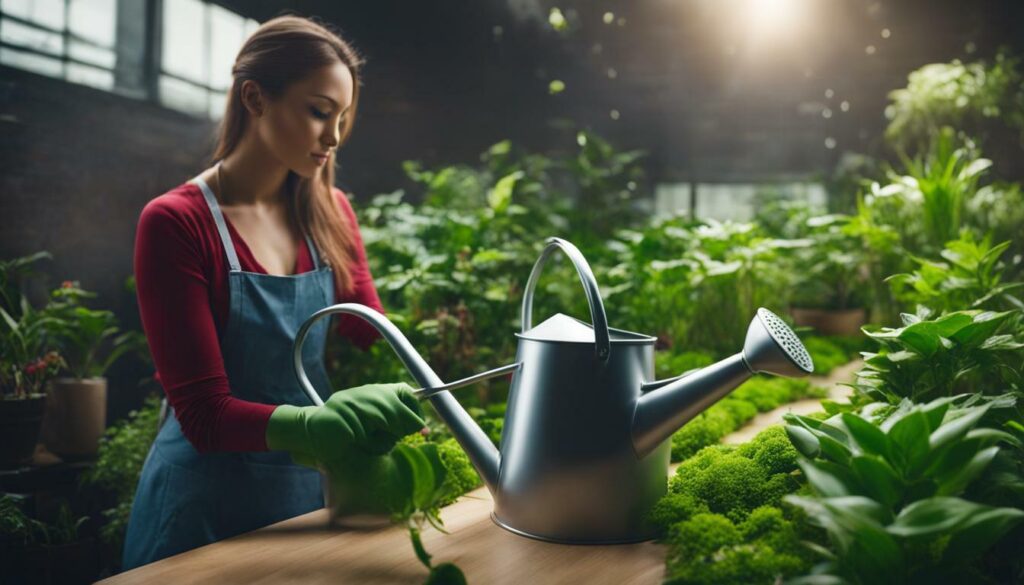
“Proper maintenance and care are essential for the success of your vertical indoor garden, including regular watering, pruning, and pest control.” – Vertical Gardening Expert
Choosing Plants for Your Vertical Indoor Garden
Choose the perfect plants for your vertical indoor garden, such as low-light varieties, herbs, and easy-to-grow vegetables. Vertical gardening offers a unique opportunity to grow a variety of plants in a small space, making it ideal for urban dwellers or those with limited outdoor areas. Whether you’re looking to add some greenery to your living space or want to grow your own fresh herbs and vegetables, selecting the right plants is essential for the success of your vertical indoor garden.
Low-Light Plants
When choosing plants for your vertical indoor garden, consider low-light varieties that can thrive in indoor environments. Popular options include pothos, spider plants, peace lilies, and ferns. These plants have adapted to low-light conditions and can tolerate the limited sunlight often found indoors. They not only add beauty to your space with their lush foliage but also improve air quality by filtering toxins and releasing oxygen.
Herbs
H herbs are another excellent choice for vertical indoor gardens. They not only provide fresh flavors for cooking but also add fragrance and visual interest to your space. Consider growing herbs such as mint, rosemary, basil, parsley, oregano, sage, and thyme. These herbs are relatively easy to grow and can thrive in indoor environments with proper care. Placing them near a sunny window or using grow lights can ensure they receive adequate light for healthy growth.
Vegetables
If you’re interested in growing your own vegetables, vertical indoor gardens can provide a space-saving solution. Opt for easy-to-grow vegetables that don’t require a large root system, such as lettuce, spinach, kale, and cherry tomatoes. These vegetables can be grown vertically using trellises or hanging baskets. Be sure to provide adequate support for vining plants and monitor their water and nutrient requirements to ensure optimal growth.
When selecting plants for your vertical indoor garden, consider their maintenance requirements, compatibility with other plants, and the available space and lighting conditions in your home. Experiment with different plant combinations to create a visually appealing and thriving vertical garden that enhances your living space.
| Low-Light Plants | Herbs | Vegetables |
|---|---|---|
| Pothos | Mint | Lettuce |
| Spider Plants | Rosemary | Spinach |
| Peace Lilies | Basil | Kale |
| Ferns | Parsley | Cherry Tomatoes |
These are just a few examples of plants that thrive in vertical indoor gardens. Explore different plant varieties and experiment with combinations to create a personalized and successful vertical garden in your home.
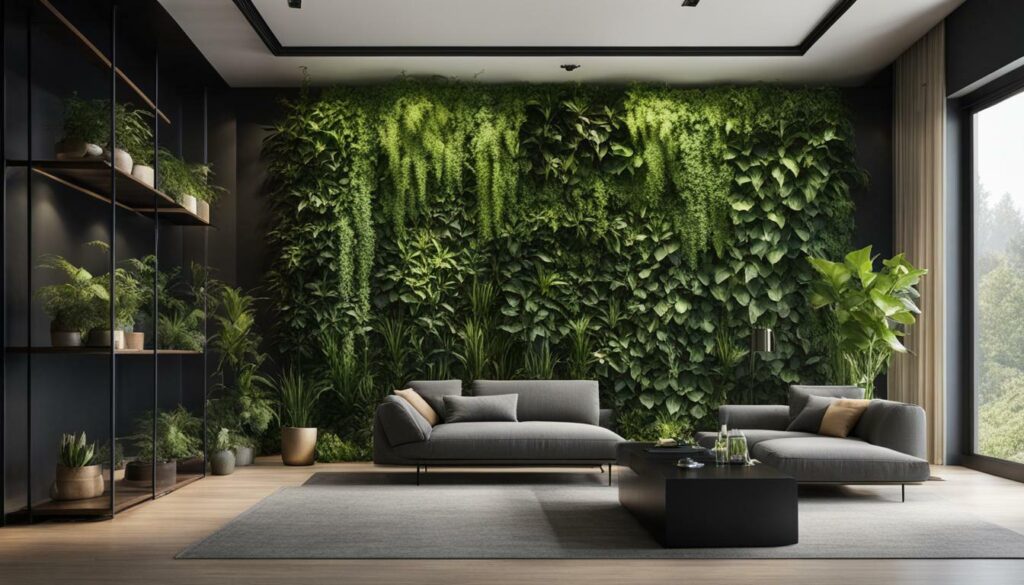
Choose the perfect plants for your vertical indoor garden, such as low-light varieties, herbs, and easy-to-grow vegetables.
Vertical gardening offers a unique opportunity to grow a variety of plants in a small space, making it ideal for urban dwellers or those with limited outdoor areas.
- Consider low-light varieties like pothos, spider plants, peace lilies, and ferns, which can thrive in indoor environments.
- Herbs like mint, rosemary, basil, parsley, oregano, sage, and thyme are great options that add both flavor and fragrance to your space.
- Easy-to-grow vegetables such as lettuce, spinach, kale, and cherry tomatoes are perfect for vertical gardens.
Select plants that are compatible with each other and consider their maintenance requirements, available space, and lighting conditions in your home. Experiment with different combinations to create a visually appealing and thriving vertical garden.
Setting Up a Vertical Indoor Garden
Get started with setting up your vertical indoor garden using convenient vertical garden kits, such as the ones offered by Gardyn. These kits provide an easy and hassle-free way to transform your living space into a vibrant and green oasis. With a vertical garden kit, you can enjoy the benefits of indoor gardening without the need for extensive knowledge or experience.
Vertical garden kits come with all the necessary components and instructions to help you set up your garden quickly and efficiently. They typically include modular panels that can be easily assembled and mounted on a wall, as well as integrated irrigation systems that ensure your plants receive the right amount of water.
| Vertical Garden Kit | Features | Price |
|---|---|---|
| Gardyn Home Kit 2.0 | – Customizable lighting and watering schedules – Automatic sensors for temperature, humidity, water, and light – Intelligent monitoring with AI technology | $799 |
| Gardyn Home Kit 3.0 | – Upgraded, more durable design – Easy assembly and cleaning – Eco-friendly features | $999 |
With Gardyn’s vertical garden kits, you have access to a range of powerful features that make indoor gardening a breeze. The customizable lighting and watering schedules ensure your plants receive optimal conditions for growth. The automatic sensors monitor essential parameters and make adjustments as needed, taking the guesswork out of plant care. Plus, the intelligent monitoring system, powered by AI technology, provides real-time alerts and expert recommendations to help you maintain a thriving garden.
Transform your living space with Gardyn’s vertical garden kits and enjoy the beauty and benefits of a vertical indoor garden. With their innovative features and user-friendly design, Gardyn is leading the way in vertical indoor gardening. Start your gardening journey today and revolutionize your space with a vertical indoor garden.
Comparison of Vertical Indoor Garden Kits
Compare the features and prices of various vertical garden kits, including the offerings of the renowned brand Gardyn. When choosing a vertical indoor garden kit, it’s important to consider factors such as ease of setup, functionality, and plant selection. Below, we compare different kits to help you make an informed decision:
| Brand | Features | Price |
|---|---|---|
| Gardyn | Customizable lighting and watering schedules, temperature and humidity sensors, AI monitoring | $799 (Home Kit 2.0) – $999 (Home Kit 3.0) |
| Brand X | Basic lighting and watering functions, limited sensor capabilities | $349 |
| Brand Y | Automatic lighting and watering systems, nutrient optimization | $599 |
Gardyn, a leading brand in vertical indoor gardening, offers two home vertical garden kits: the Home Kit 2.0 and the Home Kit 3.0. Both kits provide customizable lighting and watering schedules, temperature and humidity sensors, and AI monitoring. The Home Kit 3.0 offers an upgraded, more durable design and is priced at $999, while the Home Kit 2.0 is priced at $799. With Gardyn’s kits, you can easily grow a variety of fruits, greens, vegetables, and herbs without the need for intensive setup or gardening knowledge.
Other brands, such as Brand X and Brand Y, offer more budget-friendly options. Brand X provides basic lighting and watering functions with limited sensor capabilities at a price of $349. Brand Y offers automatic lighting and watering systems with nutrient optimization features for $599. While these kits may be more affordable, they may lack the advanced features and functionality of Gardyn’s kits.
When comparing vertical garden kits, it’s important to consider your specific needs and budget. Gardyn provides a comprehensive solution for vertical indoor gardening, with innovative features and reliable performance. However, if budget is a concern, there are other brands available that offer more affordable options with basic functionalities.
Summary:
Compare the features and prices of various vertical garden kits, including the offerings of the renowned brand Gardyn. Gardyn offers two home vertical garden kits – the Home Kit 2.0 and the Home Kit 3.0 – with customizable lighting and watering schedules, temperature and humidity sensors, and AI monitoring. The Home Kit 2.0 is priced at $799, while the Home Kit 3.0 is priced at $999. Other brands, such as Brand X and Brand Y, offer more budget-friendly options with basic functionalities. When choosing a vertical garden kit, it’s important to consider your specific needs and budget.

Expert Tips for Placing Your Vertical Indoor Garden
Enhance the growth of your vertical indoor garden with expert tips on placing it strategically to maximize natural light and ensure accessibility. The placement of your vertical indoor garden plays a crucial role in its overall health and productivity. By considering factors such as sunlight exposure, space optimization, and safety, you can create an ideal environment for your plants to thrive.
Maximizing Natural Light
One of the most important factors for the success of your vertical indoor garden is access to natural light. Most plants require at least six hours of sunlight each day to grow properly. When positioning your garden, prioritize areas near windows or other sources of natural light. Make sure the plants receive adequate sunlight without being exposed to intense heat or direct sunlight for extended periods. Consider using sheer curtains or blinds to filter the light if necessary.
For rooms with limited natural light, you can supplement it with artificial grow lights. LED grow lights are energy-efficient and mimic the spectrum of sunlight, providing the necessary light for plant growth. Ensure that the lights are positioned at an appropriate distance from the plants to prevent burning or stunted growth.
Ensuring Accessibility and Safety
When placing your vertical indoor garden, consider accessibility and safety. Ensure that the garden is easily reachable for watering, pruning, and maintenance. If possible, position it at an appropriate height to avoid straining or bending while tending to the plants. This is especially important if you have mobility concerns or limited physical capabilities.
If you have children or pets in your home, take precautions to keep the garden out of their reach. Opt for wall-mounted vertical garden systems or secure freestanding structures to prevent accidental damage or ingestion of plants. It’s also advisable to research the toxicity of the plants you choose and select non-toxic varieties to ensure the safety of your loved ones.
Optimizing Space
Make the most of the available space by carefully considering the size and layout of your vertical indoor garden. Measure the area where you plan to install the garden and select a system that fits the dimensions. Consider vertical garden kits that provide modular options, allowing you to customize the layout according to your space constraints and aesthetic preferences.
Additionally, utilize the vertical space efficiently by maximizing the number of plants you can grow. Opt for compact plants or varieties that can be trained to grow vertically, such as vining plants or those with trailing foliage. This will help create a lush and visually appealing garden while making efficient use of limited space.
By following these expert tips for placing your vertical indoor garden, you can create an optimal environment for your plants to thrive. Remember to consider natural light, accessibility, and space optimization to ensure the health and productivity of your garden.
Gardyn: Leading the Way in Vertical Indoor Gardening
Discover the innovative features of Gardyn, a pioneer in vertical indoor gardening, with its advanced AI monitoring and user-friendly design. Gardyn offers a range of home indoor vertical gardening products, including the Home Kit 2.0 and the Home Kit 3.0. Both kits provide powerful features and functionality to enhance your indoor gardening experience.
Gardyn’s hydroponic gardening system, built with patented Hybriponics® technology, allows you to effortlessly grow a variety of fruits, greens, vegetables, and herbs in a small space. The Gardyn systems are designed for easy setup and provide customizable automatic lighting and watering schedules. These systems also come equipped with automatic sensors that monitor temperature, humidity, water, and light levels to ensure your plants are receiving optimal care.
Gardyn goes beyond traditional gardening methods with its AI monitoring system. The AI, named Kelby, alerts you to potential problems and recommends solutions, making it an excellent tool for novice gardeners who may be unfamiliar with plant care. Kelby’s intelligent monitoring capabilities provide peace of mind and help you maintain successful growth for your indoor garden.
| Features | Home Kit 2.0 | Home Kit 3.0 |
|---|---|---|
| Customizable automatic lighting and watering schedules | ✔️ | ✔️ |
| Automatic temperature, humidity, water, and light sensors | ✔️ | ✔️ |
| AI monitoring with Kelby | ❌ | ✔️ |
| Eco-friendly water system | ✔️ | ✔️ |
| Vacation mode for energy-saving | ✔️ | ✔️ |
With Gardyn, you can enjoy fresh and healthy food right in your home, all year round. The vertical indoor gardening kits are designed for maximum efficiency and sustainability. They use 95% less water than conventional gardening methods, making them an eco-friendly choice for the environmentally conscious. Gardyn’s vacation mode allows you to pause growing while conserving energy, ensuring your plants stay fresh even when you’re away.
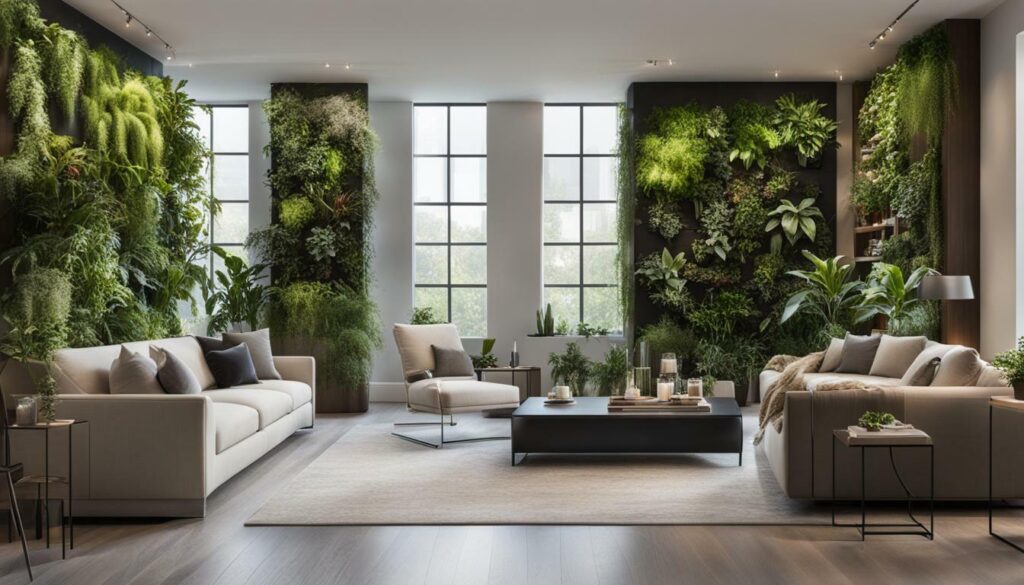
Experience the future of indoor gardening with Gardyn, a brand that is leading the way in vertical indoor gardening. Whether you’re a seasoned gardener or a beginner, Gardyn provides the tools and technology to create a thriving indoor garden in any space. Explore the options offered by Gardyn’s Home Kit 2.0 and Home Kit 3.0 and start enjoying the benefits of fresh and sustainable homegrown produce.
Compare Gardyn’s Home Kits
If you’re interested in finding the perfect indoor gardening solution for your home, compare Gardyn’s Home Kit 2.0 and Home Kit 3.0 to determine which one suits your needs best. Both kits offer advanced features and functionality, providing a convenient and efficient way to grow your own food. Take a closer look at the table below to see the similarities and differences between the two kits.
| Features | Home Kit 2.0 | Home Kit 3.0 |
|---|---|---|
| Design | Elegant and sleek | Upgraded, more durable design |
| Set-Up | Easy and straightforward | Easier to put together and clean |
| Functionality | Powerful features for optimal plant growth | Same powerful features as Home Kit 2.0 |
Discover the possibilities of vertical indoor gardening with Gardyn’s Home Kits and start growing your own fresh and sustainable produce today.
Conclusion
In conclusion, a vertical indoor garden offers numerous benefits, from improving indoor air quality to maximizing space, and with the right care and plant selection, it can revolutionize your living space.
The Benefits of a Vertical Indoor Garden
A vertical indoor garden not only adds greenery and beauty to your living space but also provides several practical advantages. By filtering toxins and releasing oxygen, it improves indoor air quality, creating a healthier and more pleasant environment. Additionally, vertical gardens act as natural insulation, regulating humidity levels and reducing the need for excessive heating or cooling. This eco-friendly approach to gardening also promotes sustainable living, as it requires less water and space compared to traditional gardens.
Furthermore, vertical indoor gardens offer an opportunity for creative design and customization. By maximizing space and incorporating appropriate lighting, you can create a stunning focal point in your home that complements your existing decor.
Gardening Tips for Vertical Indoor Gardens
When caring for a vertical indoor garden, it is important to follow a few key tips. Regular watering is essential to keep the plants healthy and thriving. Pruning is also necessary to prevent overcrowding and promote optimal growth. Additionally, implementing pest control measures will help protect your plants from infestations and diseases.
When selecting plants for your vertical indoor garden, consider low-light varieties, such as pothos, spider plants, and peace lilies, which are well-suited for indoor environments. Herbs like basil, mint, and rosemary are also popular choices that add fragrance and flavor to your space.
Setting Up a Vertical Indoor Garden with Gardyn
Gardyn is a leading provider of vertical indoor garden kits that are designed to be user-friendly and efficient. With their innovative features and AI monitoring, even novice gardeners can successfully grow a thriving vertical garden. Gardyn offers different models, such as the Home Kit 2.0 and the Home Kit 3.0, both of which provide customizable lighting and watering schedules, automatic sensors, and intelligent monitoring. These eco-friendly systems use minimal water and energy, making them an ideal choice for sustainable living.
When setting up your vertical indoor garden, consider the placement to maximize natural light and ensure accessibility. Placing the garden near windows and in areas where pets and children cannot disturb it is recommended. Following these expert tips will help you create a vibrant and flourishing vertical indoor garden that enhances your living space.
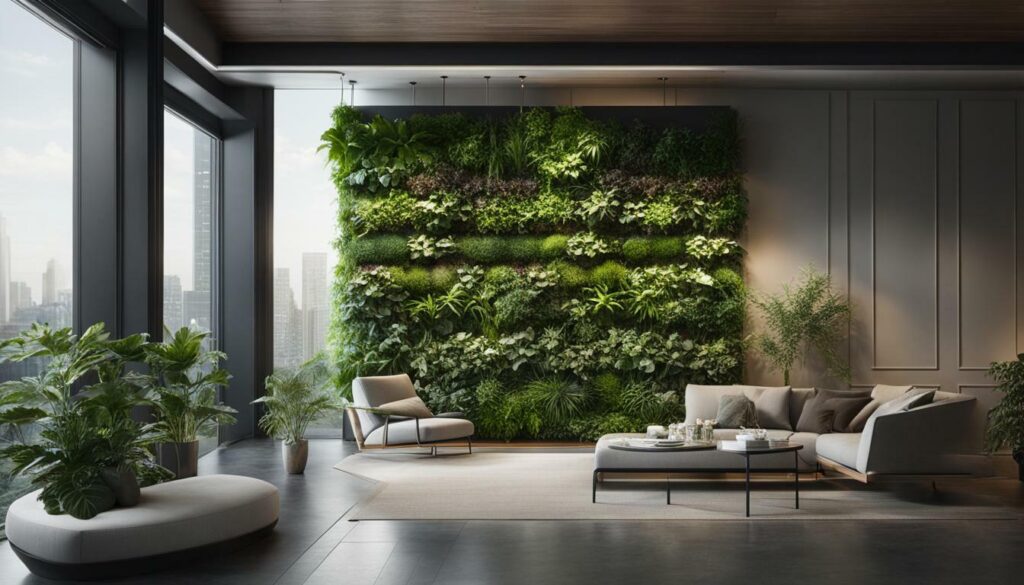
| Benefits of a Vertical Indoor Garden: | Tips for Vertical Indoor Garden Maintenance: |
|---|---|
| – Improved indoor air quality – Natural insulation – Space optimization – Eco-friendly living | – Regular watering – Pruning for optimal growth – Pest control measures |
| Popular Plants for Vertical Indoor Gardens: | Gardyn: Leading the Way in Vertical Indoor Gardening |
| – Low-light plants: pothos, spider plants, peace lilies – Herbs: basil, mint, rosemary | – Innovative features and AI monitoring – Home Kit 2.0 and Home Kit 3.0 options |
FAQ – Frequently Asked Questions about Vertical Indoor Gardens
Find answers to common questions about vertical indoor gardens, including installation tips, lighting requirements, and plant selection.
1. Can indoor vertical gardens be installed in any living space?
Yes, indoor vertical gardens can be installed in almost any living space. Whether you have a small apartment or a spacious home, vertical gardens can be customized to fit your specific needs and available space.
2. Can an indoor vertical garden replace the need for traditional outdoor gardens?
An indoor vertical garden can be a great addition to your living space, but it may not entirely replace the need for a traditional outdoor garden. Outdoor gardens offer a wider range of plants and provide an immersive experience with nature. However, indoor vertical gardens can complement outdoor gardens, especially in urban areas where outdoor spaces may be limited.
3. How much natural light do indoor vertical gardens require?
The amount of natural light required for an indoor vertical garden depends on the specific plants you choose. Some plants thrive in low-light conditions and can survive with minimal sunlight, while others require bright indirect light. Understanding the light requirements of your chosen plants is crucial for their successful growth.
4. What are some suitable plants for an indoor vertical garden?
Plants with shallow roots and those that thrive in container gardening are suitable for an indoor vertical garden. Some popular choices include succulents, small cacti, herbs like mint and basil, and trailing plants like ivy. Select plants that can coexist in a vertical arrangement and consider their maintenance requirements.
5. How do I install an indoor vertical garden?
Installing an indoor vertical garden typically involves securing the structure to the desired surface and attaching the planters or pockets for the plants. It’s important to follow the manufacturer’s instructions or seek professional assistance for proper installation. Consider factors such as available space, lighting conditions, and the desired aesthetic when setting up your vertical garden.
6. How do I care for an indoor vertical garden?
Maintaining an indoor vertical garden involves regular watering, pruning to prevent overcrowding, monitoring and controlling pests, and providing necessary nutrients through fertilization. It’s important to check the moisture levels of the soil, ensure proper drainage, and provide appropriate lighting for the plants. Each plant may have specific care requirements, so it’s essential to research and understand the needs of the plants in your vertical garden.
7. Are there any potential challenges or considerations for indoor vertical gardens?
While indoor vertical gardens offer many benefits, there are some challenges to consider. These include the initial cost of setting up a vertical garden system, the limited variety of plants compared to traditional gardens, reliance on utilities such as electricity and water supply, and potential impacts from curious pets or children in the household. It’s important to weigh these factors and determine if an indoor vertical garden aligns with your lifestyle and preferences.
8. Are there professional services available for designing and maintaining indoor vertical gardens?
Yes, there are professional services available for designing, installing, and maintaining indoor vertical gardens. These services can provide expertise in plant selection, system installation, and ongoing care. Hiring a professional can ensure the success and longevity of your indoor vertical garden, especially if you’re new to gardening or have specific design requirements.
Are Vertical Wall Gardens Suitable for Indoor Spaces to Revolutionize the Area?
Vertical wall gardens can easily transform your indoor space into a lush green oasis. They are suitable for any indoor setting and help revolutionize the area by adding a touch of nature. These gardens not only look stunning but also provide numerous health benefits and improve air quality.
FAQ
Q: What is a vertical indoor garden?
A: A vertical indoor garden is a type of garden that allows plants to grow vertically without needing soil. It utilizes hydroponics, where plants are grown in nutrient-rich water solutions, and maximizes the number of plants that can be grown in a small space.
Q: What are the benefits of a vertical indoor garden?
A: Vertical indoor gardens improve indoor air quality, regulate humidity levels, act as natural insulation, and provide a source of fresh food. They also promote eco-friendly living and maximize the use of space.
Q: How do I design a vertical indoor garden?
A: When designing a vertical indoor garden, consider maximizing the available space, choosing appropriate lighting, and integrating the garden into the existing decor of the space. Prioritize placement near windows for natural light and ensure the garden has room to grow without being disturbed by children or pets.
Q: How do I maintain a vertical indoor garden?
A: Vertical indoor gardens require regular watering, pruning to prevent overcrowding, and pest control measures. It’s important to monitor soil moisture levels, provide necessary nutrients through fertilization, and ensure proper care for the plants to thrive.
Q: What plants are suitable for a vertical indoor garden?
A: Plants that are suitable for a vertical indoor garden include low-light plants, herbs, and vegetables. Popular choices include succulents, small cacti, pothos, spider plants, peace lilies, ferns, mint, rosemary, basil, parsley, oregano, sage, and thyme.
Q: How do I set up a vertical indoor garden?
A: Setting up a vertical indoor garden can be done with the help of vertical garden kits, such as those offered by Gardyn. These kits come with instructions and provide everything needed to get started. Alternatively, DIY options are available where you can customize the setup according to your preferences.
Q: What makes Gardyn a leading brand in vertical indoor gardening?
A: Gardyn stands out as a leading brand in vertical indoor gardening due to its innovative features and commitment to providing ease of gardening for all levels of expertise. With features like AI monitoring, eco-friendly technology, and customizable, automatic schedules, Gardyn offers a superior gardening experience.
Q: How can I maximize the natural light for my vertical indoor garden?
A: To maximize natural light for your vertical indoor garden, prioritize placement near windows and assess the available natural light in the chosen area. If there is limited natural light, consider using grow lights to supplement the lighting conditions for the plants.
Q: Can a vertical indoor garden be installed in any living space?
A: Yes, a vertical indoor garden can be installed in almost any living space, whether it’s a small apartment or a spacious home. The size and design of the vertical garden can be customized to fit the specific needs and available space.
Q: Can a vertical indoor garden replace the need for traditional outdoor gardens?
A: While a vertical indoor garden can be a great addition to a living space, it may not entirely replace the need for a traditional outdoor garden. Outdoor gardens offer a wider range of plants and a more immersive experience with nature. However, vertical indoor gardens can complement outdoor gardens, especially in urban areas where outdoor spaces may be limited.
Q: How much water does a vertical indoor garden need?
A: The water requirements for a vertical indoor garden depend on the specific plants being grown and the environmental conditions. It’s important to regularly check soil moisture levels and water accordingly. Overwatering should be avoided to prevent damage to the plants.

